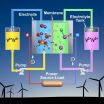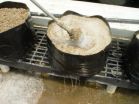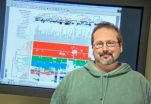(Press-News.org) RICHLAND, Wash. – Though considered a promising large-scale energy storage device, the vanadium redox battery's use has been limited by its inability to work well in a wide range of temperatures and its high cost. But new research indicates that modifying the battery's electrolyte solution significantly improves its performance. So much so that the upgraded battery could improve the electric grid's reliability and help connect more wind turbines and solar panels to the grid.
In a paper published by the journal Advanced Energy Materials, researchers at the Department of Energy's Pacific Northwest National Laboratory found that adding hydrochloric acid to the sulfuric acid typically used in vanadium batteries increased the batteries' energy storage capacity by 70 percent and expanded the temperature range in which they operate.
"Our small adjustments greatly improve the vanadium redox battery," said lead author and PNNL chemist Liyu Li. "And with just a little more work, the battery could potentially increase the use of wind, solar and other renewable power sources across the electric grid."
Unlike traditional power, which is generated in a reliable, consistent stream of electricity by controlling how much coal is burned or water is sent through dam turbines, renewable power production depends on uncontrollable natural phenomena such as sunshine and wind. Storing electricity can help smooth out the intermittency of renewable power while also improving the reliability of the electric grid that transmits it.
Vanadium batteries can hold on to renewable power until people turn on their lights and run their dishwashers. Other benefits of vanadium batteries include high efficiency and the ability to quickly generate power when it's needed as well as sit idle for long periods of time without losing storage capacity.
A vanadium battery is a type of flow battery, meaning it generates power by pumping liquid from external tanks to the battery's central stack, or a chamber where the liquids are mixed. The tanks contain electrolytes, which are liquids that conduct electricity. One tank has the positively-charged vanadium ion V5+ floating in its electrolyte. And the other tank holds an electrolyte full of a different vanadium ion, V2+. When energy is needed, pumps move the ion-saturated electrolyte from both tanks into the stack, where a chemical reaction causes the ions to change their charge, creating electricity.
To charge the battery, electricity is sent to the vanadium battery's stack. This causes another reaction that restores the original charge of vanadium ions. The electrical energy is converted into chemical energy stored in the vanadium ions. The electrolytes with their respective ions are pumped back into to their tanks, where they wait until electricity is needed and the cycle is started again.
A battery's capacity to generate electricity is limited by how many ions it can pack into the electrolyte. Vanadium batteries traditionally use pure sulfuric acid for their electrolyte. But sulfuric acid can only absorb so many vanadium ions.
Another drawback is that sulfuric acid-based vanadium batteries only work between about 50 and 104 degrees Fahrenheit (10 to 40 Celsius). Below that temperature range, the ion-infused sulfuric acid crystallizes. The larger concern, however, is the battery overheating, which causes an unwanted solid to form and renders the battery useless. To regulate the temperature, air conditioners or circulating cooling water are used, which causes up to 20 percent energy loss and significantly increasing the battery's operating cost, the researchers noted.
Wanting to improve the battery's performance, Li and his colleagues began searching for a new electrolyte. They tried a pure hydrochloric acid electrolyte, but found it caused one of the vanadium ions to form an unwanted solid. Next, they experimented with various mixtures of both hydrochloric and sulfuric acids. PNNL scientists found the ideal balance when they mixed 6 parts hydrochloric acid with 2.5 parts sulfuric acid. They verified the electrolyte and ion molecules present in the solution with a nuclear magnetic resonance instrument and the Chinook supercomputer at EMSL, DOE's Environmental Molecular Sciences Laboratory at PNNL.
Tests showed that the new electrolyte mixture could hold 70 percent more vanadium ions, making the battery's electricity capacity 70 percent higher. The discovery means that smaller tanks can be used to generate the same amount of power as larger tanks filled with the old electrolyte.
And the new mixture allowed the battery to work in both warmer and colder temperatures, between 23 and 122 degrees Fahrenheit (-5 to 50 Celsius), greatly reducing the need for costly cooling systems. At room temperature, a battery with the new electrolyte mixture maintained an 87 percent energy efficiency rate for 20 days, which is about the same efficiency of the old solution.
The results are promising, but more research is needed, the authors noted. The battery's stack and overall physical structure could be improved to increase power generation and decrease cost.
"Vanadium redox batteries have been around for more than 20 years, but their use has been limited by a relatively narrow temperature range," Li said. "Something as simple as adjusting the batteries' electrolyte means they can be used in more places without having to divert power output to regulate heat."
INFORMATION:
This research was supported by DOE's Office of Electricity Delivery and Energy Reliability and internal PNNL funding.
REFERENCE: Liyu Li, Soowhan Kim, Wei Wang, M. Vijaayakumar, Zimin Nie, Baowei Chen, Jianlu Zhang, Guanguang Xia, Jianzhi Hu, Gordon Graff, Jun Liu, Zhenguo Yang. A Stable Vanadium Redox-Flow Battery with High Energy Density for Large-Scale Energy Storage. Advanced Energy Materials. Published online March 11, 2011. http://onlinelibrary.wiley.com/doi/10.1002/aenm.201100008/abstract;jsessionid=1A732376F09811F2200A9CB8D1AE5891.d03t04
Pacific Northwest National Laboratory (www.pnl.gov) is a Department of Energy Office of Science national laboratory where interdisciplinary teams advance science and technology and deliver solutions to America's most intractable problems in energy, the environment and national security. PNNL employs 4,900 staff, has an annual budget of nearly $1.1 billion, and has been managed by Ohio-based Battelle since the lab's inception in 1965. Follow PNNL on Facebook, LinkedIn and Twitter.
EMSL, the Environmental Molecular Sciences Laboratory, (www.emsl.pnl.gov) is a national scientific user facility sponsored by the Department of Energy's Office of Science, Biological and Environmental Research program that is located at Pacific Northwest National Laboratory. EMSL offers an open, collaborative environment for scientific discovery to researchers around the world. EMSL's technical experts and suite of custom and advanced instruments are unmatched. Its integrated computational and experimental capabilities enable researchers to realize fundamental scientific insights and create new technologies. Follow EMSL on Facebook.
Upgrading the vanadium redox battery
New electrolyte mix increases energy storage by 70 percent
2011-03-18
ELSE PRESS RELEASES FROM THIS DATE:
Optimizing yield and fruit size of figs
2011-03-18
SOUTH AFRICA—The common fig is a subtropical, deciduous fruit tree grown in most Mediterranean-type climates. Although some believe that figs may be the oldest cultivated fruit species on earth, global expansion of fig crops has been hindered by the narrow research base pertaining to production practices and the limited number of fig cultivars currently available. Recently, three black figs were established in the Mediterranean-type climate of Western Cape Province of South Africa to provide fruit for fresh markets throughout South Africa and Europe.
Hein J. Gerber, Willem ...
New software calculates heating costs in greenhouse operations
2011-03-18
TOLEDO, OH—In parts of the United States where ornamental and vegetable plants are produced in greenhouses during cold seasons, heating costs are second only to labor costs for greenhouse operators. Greenhouse growers are faced with important management decisions that rely on understanding how temperature settings, heating systems, fuel types, and construction decisions influence their heating costs. To address the lack of user-friendly computer programs currently available for calculating heating costs in greenhouse operations, scientists have created a state-of-the-art ...
Recycling perlite: New, improved method saves resources
2011-03-18
BOSSIER CITY, LA—Perlite, a processed volcanic mineral, is widely used as a component of soilless growing mixes. Lightweight, sterile, and easy to use, perlite is popular with greenhouse growers. But because salt and pathogen buildup can occur when perlite is reused, it must be replaced every year or two to minimize the risk of crop failure. The cost of disposing of old material and replacing it with new perlite can be significant and often prohibitive for smaller greenhouse operations. Hanna Y. Hanna, a researcher at Louisiana State University Agricultural Center's Red ...
Horticulture students link problem-solving to employment
2011-03-18
AMES, IA—Recognizing the need for university students to develop problem-solving skills they will need in their careers, educators are looking to student-centered, problem-based learning strategies. Problem-based learning (PBL) experiences have been shown to promote higher-order thinking skills in students, but, for faculty, implementing and assessing problem-based activities often means a substantial time investment. Iowa State University professor Ann Marie VanDerZanden and graduate student Tigon Woline published a study in HortTechnology that reported on an innovative ...
Berkeley Lab scientists take a look at systems biology and cellular networking
2011-03-18
Systems biology is a holistic approach to the study of how a living organism emerges from the interactions of the individual elements that make up its constituent cells. Embracing a broad range of disciplines, this field of science that is just beginning to come into public prominence holds promise for advances in a number of important areas, including safer, more effective pharmaceuticals, improved environmental remediation, and clean, green, sustainable energy. However, the most profound impact of systems biology, according to one of its foremost practitioners, is that ...
Gardening linked to increased vegetable consumption in older adults
2011-03-18
COLLEGE STATION, TX—New research from Texas A&M University and Texas State University found that older adults who participate in gardening may be more likely to eat their veggies. The report, published in HortTechnology, presents the results of an online survey of adults aged 50+ and includes recommendations for promoting gardening "intervention" programs to older adults.
According to researchers Aime Sommerfeld, Amy McFarland, Tina Waliczek, and Jayne Zajicek, studies have shown that poor nutrition is one of several factors responsible for mortality and morbidity in ...
Corn gluten meal tested on squash survival, yields
2011-03-18
LANE, OK—Corn gluten meal, a powdery byproduct of the wet-milling process of corn, has shown important potential for use as an organic, non-selective preemergence or preplant-incorporated herbicide. A team of researchers from the U.S. Department of Agriculture-Agricultural Research Service and Oklahoma State University recently reported on the impact of corn gluten meal (CGM) applications on direct-seeded squash (Cucurbita pepo), and determined that CGM can be effective and safe if used in banded applications.
Used for years as a supplement in dog, fish, and livestock ...
Want more zest for life? Consider gardening!
2011-03-18
COLLEGE STATION, TX—Does gardening contribute to quality of life and increased wellness for older adults? Researchers from the Texas A&M and Texas State Universities asked these questions in a survey of people aged 50 and older. The survey revealed some compelling reasons for older adults to get themselves out in the garden.
Aime Sommerfeld, Jayne Zajicek, and Tina Waliczek designed a questionnaire to investigate older adult gardeners' and nongardeners' perceptions of personal life satisfaction and levels of physical activity. According to Sommerfeld, lead author of the ...
New research tool targets microRNA expression in zebrafish
2011-03-18
New Rochelle, NY, March 17, 2011—A new research tool for studying microRNA expression in zebrafish will help researchers study the effects of miRNA on the early development of this model organism and better understand developmental and disease mechanisms in humans, as described in Zebrafish, a peer-reviewed journal published by Mary Ann Liebert, Inc. The article is available free online ahead of print.
Researchers from University of Oregon (Eugene) have developed a novel, cost-effective method for measuring the expression of microRNAs (miRNA) in specific tissues in ...
Solar greenhouses: China's winning solution to global energy crisis
2011-03-18
BEIJING, CHINA—Solar greenhouses have played a vital role in China's agricultural scene for years. New innovations in greenhouse design are allowing growers to produce more varieties of vegetables, even during long winter months. In a recently published report Chinese scientists called solar greenhouses "the most important type of infrastructures for growing horticultural crops in China." The team of researchers from the College of Agronomy and Biotechnology at China Agricultural University presented an extensive report on single-slope solar greenhouses in a recent issue ...
LAST 30 PRESS RELEASES:
Numbers in our sights affect how we perceive space
SIMJ announces global collaborative book project in commemoration of its 75th anniversary
Air pollution exposure and birth weight
Obstructive sleep apnea risk and mental health conditions among older adults
How talking slows eye movements behind the wheel
The Ceramic Society of Japan’s Oxoate Ceramics Research Association launches new international book project
Heart-brain connection: international study reveals the role of the vagus nerve in keeping the heart young
Researchers identify Rb1 as a predictive biomarker for a new therapeutic strategy in some breast cancers
Survey reveals ethical gaps slowing AI adoption in pediatric surgery
Stimulant ADHD medications work differently than thought
AI overestimates how smart people are, according to HSE economists
HSE researchers create genome-wide map of quadruplexes
Scientists boost cell "powerhouses" to burn more calories
Automatic label checking: The missing step in making reliable medical AI
Low daily alcohol intake linked to 50% heightened mouth cancer risk in India
American Meteorological Society announces Rick Spinrad as 2026 President-Elect
Biomass-based carbon capture spotlighted in newly released global climate webinar recording
Illuminating invisible nano pollutants: advanced bioimaging tracks the full journey of emerging nanoscale contaminants in living systems
How does age affect recovery from spinal cord injury?
Novel AI tool offers prognosis for patients with head and neck cancer
Fathers’ microplastic exposure tied to their children’s metabolic problems
Research validates laboratory model for studying high-grade serous ovarian cancer
SIR 2026 delivers transformative breakthroughs in minimally invasive medicine to improve patient care
Stem Cell Reports most downloaded papers of 2025 highlight the breadth and impact of stem cell research
Oxford-led study estimates NHS spends around 3% of its primary and secondary care budget on the health impacts of heat and cold in England
A researcher’s long quest leads to a smart composite breakthrough
Urban wild bees act as “microbial sensors” of city health.
New study finds where you live affects recovery after a hip fracture
Forecasting the impact of fully automated vehicle adoption on US road traffic injuries
Alcohol-related hospitalizations from 2016 to 2022
[Press-News.org] Upgrading the vanadium redox batteryNew electrolyte mix increases energy storage by 70 percent




